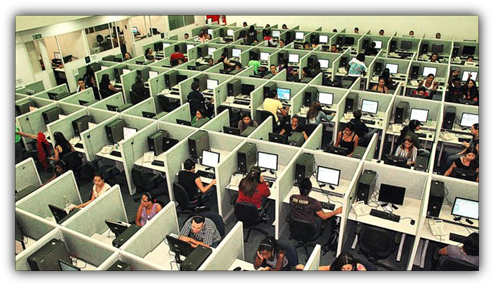In financial institutions, the process of mortgage approval starts with a Loan Officer completing a mortgage application. The completed application is sent to a Loan Processor for review and preparation the application for presentation to the Underwriter. An Underwriter is a professional authorized to assess if the application is eligible for the mortgage loan. If the application is complete, the Loan Processor sends it to the Underwriter. If the application needs more documents or revisions, the Loan Processor sends it back to the Loan Officer for reprocessing.
The Role of Globally Distributed Design and Product Architecture in Product Development Performance
RESEARCH
Studies have shown that in the United States, in 2017, the service industry accounted for $13.1 trillion in value added, which is about 79 percent of the total value added. This sector has a total of 124 million employees, which is about 86.3 percent of total private employment. In high-income countries, the average contribution of the service industry to the GDP has increased from 69 percent in 1997 to 74 percent in 2015. Clearly, the world economy is moving toward service and information economy. Researchers, therefore, have been focusing on the analysis and improvement of service operations systems such as food and lodging, medical services, transportation systems, financial services, education, government and technical services, among others. Below are some of the projects that our team has done to improve the performance of a variety of service operations systems.
SERVICE OPERATIONS
After reprocessing, the Loan Officer then sends the completed application directly to the Underwriter herself. In this process, the Loan Officer receives both new applications and applications that require reprocessing, and therefore faces the decision of whether to work on a new arriving application or on a returned application. This administrative procedure is also common in other service systems such as law offices or human resource offices. The decision of which type of application to work on next will directly affect the number of applications in the system, which in turn affects other operational performance measures such as time an application is pending for final approval and the number of applications processed each day. Motivated by this problem as well as by the opportunity for significant improvement, this project investigates how a server should make a decision about which application to work on next when there are two types of applications (i.e., new and returning applications) in her stage. Using a Markov decision process and queueing theory, we find the optimal decision under three different scenarios of full information, partial information and no information about the number of applications waiting in all stages of the process. (Joint work with S. Ansari and Q. Shao)
Geographic distribution of knowledge-intensive work is a widespread phenomenon in the global economy. Companies are increasingly internationalizing their R&D activities. New product development (NPD) is following manufacturing in being outsourced to internal and external suppliers around the globe. There are several potential benefits from geographically distributed product development, including (i) reducing labor costs, (ii) acquiring technical expertise, (iii) gaining access to local markets by incorporating diverse customer values from different cultures, and (iv) increasing efficiency by conducting round-the-clock operation.
However, globalization of design processes presents risks. For example, Boeing made a “quantum leap in farming out the design and manufacture of crucial components” for its landmark Dreamliner 787 by collaborating with around 40 global partners on the majority of the aircraft’s design, but wound up “billions of dollars over-budget, and years behind schedule”. In this empirical study of a large auto manufacturer, we examined the operational performance implications of splitting the design of vehicle subsystems across multiple geographic locations. Our results indicate that global distribution diminishes the chance of completing tasks on time and degrades subsystem design quality. Finally, by examining the interplay between subsystem centrality and global distribution, we found that higher centrality in the product architecture amplifies the impact of global distribution on subsystem error rates. The methodologies used are statistical analysis and social networks. (Joint work with B. Gokpinar and W.J. Hopp)
Improving Loan Approval Process in Financial Institutions
Approximately 3.2 to 3.3 million people work in call centers in the United States. In the United Kingdom, 4 percent of the workers, which is about one million people, work in call centers. The Philippines (1.2-1.3 million workers) and India (1.1 -1.3 million) have the largest call center outsourcing industries. Business process outsourcing including call centers accounts for about 10% of the Philippines economy.
About 60 to 70 percent of the cost of running a call center is Customer Service Representative (CSR) cost. One reason is that CSR average annual turnover rate is 40 percent. Cost of hiring and training a new CSR is between $10,000 to $15,000. Efficient management of these agents can help reduce labor cost while maintaining a short call waiting time. One strategy to reduce labor and increase customer service level is to cross-train CSRs to perform more than one task. Call centers with cross-trained CSRs constitute complex queueing networks for which analytical models are not available. In this project, using social networks as well as flow optimization algorithms, we developed several models that can identify workforce training programs that increase the flexibility of call centers and reduce their labor costs. The developed models are also applicable in designing resource structures in manufacturing systems and supply chains. (Joint work with B. Kolfal and M.P. Van Oyen)
Improving flexibility of Service Systems with multi-functional Resources
A recent report from Avaaz has highlighted rampant health misinformation on Facebook with false items receiving an estimated 3.8 billion views over the past year. During COVID-19 spread in April 2020 alone, the false content received 460 million views via Facebook pages, groups or individual profiles. The severity of the issue is made clear by the fact that content from the top-10 websites spreading health misinformation had 4-times the views of equivalent content from the official websites of top-10 health institutions over the past year.
With more than two billion Facebook users, a large amount of such misinformation and false news is posted every day. The only way to diminish the impact of misinformation is to detect it fast and inform users about its validity. Committed to fight the spread of misinformation news, social media such as Facebook use fact-checking organizations to identify false information posted on their networks. While they work with a large network of fact-checkers to identify false news, the fact-checking process can take hours or even days, during which news spreads at an exponential speed through social media.
The main challenge in fact-checking is the tradeoff between the speed of making a decision (of whether news is false or not) and the accuracy of the decision (e.g., error of identifying false news as real, or vice versa). This project models the fact-checking process as a queueing system and uses Robust Optimization and Markov Decision Process to find the optimal number of fact-checkers, and the optimal allocation of news to fact-checkers. The goal is to increase the speed of detecting misinformation while maintaining a high level of accuracy. (Joint work with C. Bandi, Z. Liu and A. Singla)
Increasing the Speed and Accuracy of Fact Checking in Social Media




